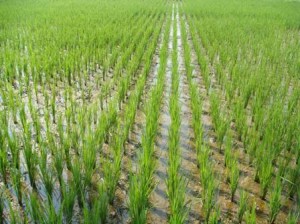
More evidence that low-calorie sweeteners are bad for your health
Studies show that artificial sweeteners can raise the risk of hypertension, metabolic syndrome, type 2 diabetes and heart disease, including stroke.

Techniques of intensifying crop production using basic and sound husbandry have led to a dramatic increase in riceproduction. The System of Rice Intensification (SRI) has increased yields by 50-100%, reduced seed use by 80-90%and irrigation by 25%-50%. These methods are now being tried with other crops with similar success.
Nearly 5 million farmers in some of the poorest parts of the world have benefitted from SRI and are working proof that genetic engineering is not the be all and end all of feeding the world.
Without the use of fertiliser, rice, the world’s most important food staple, averages a yield of 4 tonnes per hectare. With fertiliser this increases to 8 tonnes per hectare. By using SRI, this can increase to an amazing 22 tonnes per hectare.
Little or no inorganic fertilizer is required if sufficient organic matter can be provided to the soil, and there is little if any need for agrochemical crop protection against pests and diseases. SRI plants are also generally healthier and better able to resist such stresses as well as drought, extremes of temperature, flooding, and storm damage.
SRI is life changing for small farmers.
Only four simple rules
SRI methodology is based on four main principles that interact in synergistic ways:
These sound like instructions on the back of a seed packet. In practise they mean that farmers have to:
Variants of SRI practices are also suitable for upland regions where crops are rain fed, and cannot rely upon irrigation. Crops can be productive with less irrigation water or rainfall because taking up SRI recommendations enhances the capacity of soil systems to absorb and provide water.
It works by getting crop plants to grow larger, healthier, longer-lived root systems, and an increase in the health of the soil by encouraging the abundance, diversity and activity of soil organisms. These organisms create a beneficial microbiome for plants that enhances their growth, health and stress tolerance.
Not only do the yields improve, but overheads fall. The plants require less water, less inorganic inputs, less labour and the plants are showing much better resilience to environmental stresses like droughts and floods. (Thakur et al 2009; Zhao et al 2009).
From rice to other crops
SRI practices, initially developed to benefit small-scale rice growers, are being adapted now for larger-scale production, with methods such as direct-seeding instead of transplanting, and with the mechanization of some labour-intensive operations such as weeding (Sharif 2011).
Using these methods, smallholders in many different countries are starting to see greater productivity from their land. If you take into account that 70% of the world’s food is produced by small famers, (IAASTD report 2008) then the importance of this starts to become clear.
The great benefits SRI has brought to rice are now being extended to other crops under the overarching name of System of Crop Intensification (SCI). Amongst them are wheat, finger millet, teff, sugar cane, rapeseed/canola), legumes and vegetables.
Producing more output with fewer external inputs may sound like a sales pitch from the pro-GM lobby but SCI derives from a shift in emphasis from improving plant genetic potential via plant breeding, to providing optimal environments for crop growth.
Scientists, like Prof. Norman Uphoff and colleagues within the SRI network argue that more attention should be given to the contributions that are made to agricultural production by the soil biota. (Uphoff et al. 2012).
Making a real difference
Much more research and evaluation needs to be done on SCI but the kinds of results and advances that have been seen so far, just from adopting the four principles of this system, are very exciting.
Agriculture and the food system in the 21st century must change dramatically. Land and water resources are under pressure; inputs like fertilizers and pesticides are expensive and out of the question for small subsistence farmers; and climate change is making growing conditions more fragile and volatile.
The success of SRI and SCI methods are low risk, they don’t require farmers to have access to any unfamiliar technologies like GM or more expensive seeds and they don’t lock farmers on to a corporate controlled treadmill of increasing costs and dependency on external inputs.
Instead they offer farmers and farming communities’ greater security and better livelihoods. As the UN and World Bank sponsored assessment of agricultural technologies (IAASTD) concluded, it is these kinds of agro-ecological approaches and not GM which is the best chance we have of “feeding the world”.
Sources and references
http://sri.ciifad.cornell.edu/aboutsri/methods/index.html
Sharif A (2011). Technical adaptations for mechanized SRI production to achieve water saving and increased
Uphoff N (2012). Raising smallholder food crop yields with climate-smart agricultural practices. Report accompanying presentation on ‘The System of Rice Intensification (SRI) and Beyond: Coping with Climate Change,’ made at World Bank, Washington, DC, October 10.
Uphoff N, Chi F, Dazzo FB , Rodriguez RJ (2012) Soil fertility as a contingent rather than inherent characteristic: Considering the contributions of crop-symbiotic soil biota. In Principles of Sustainable Soil Systems in Agroecosystems,, eds. R. Lal and B. Stewart. Boca Raton FL: Taylor & Francis, in press.
Zhao LM, Wu LH, Li Y, Lu X, Zhu DF and Uphoff, N (2009) Influence of the system of rice intensification on rice yield and nitrogen and water use efficiency with different N application rates. Experimental Agric. 45: 275–286.

Please subscribe me to your newsletter mailing list. I have read the
privacy statement